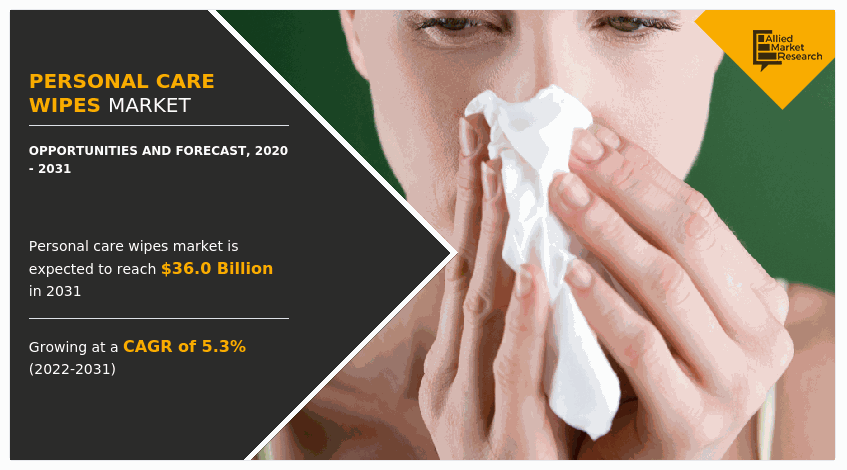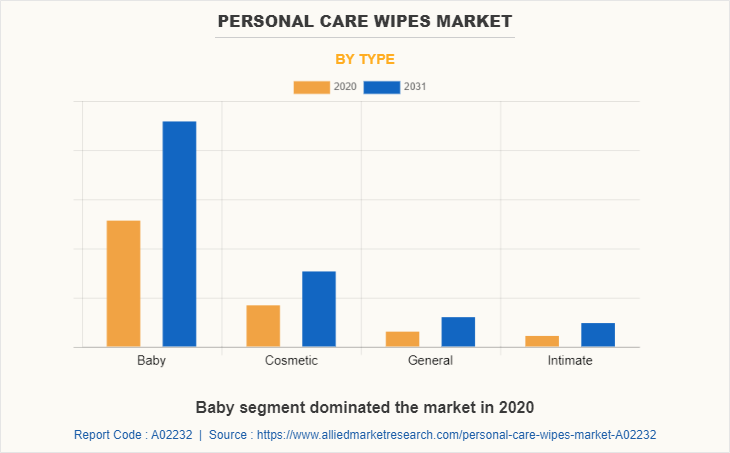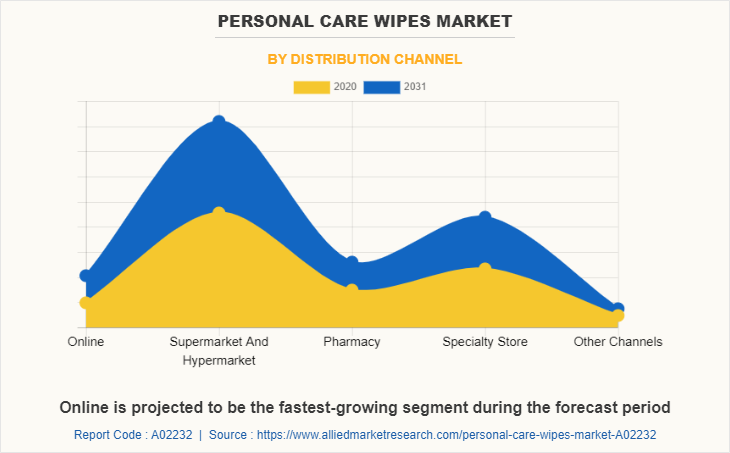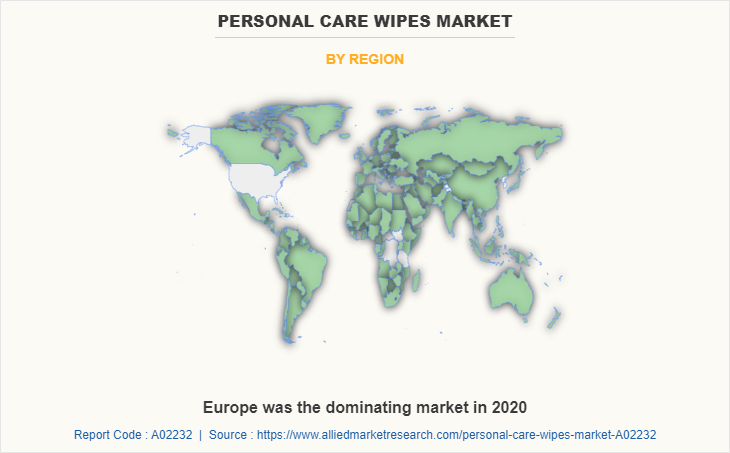Personal Care Wipes Market Research, 2031
The global personal care wipes market was valued at $19,658.10 million in 2020, and is projected to reach $35,976.57 million by 2031, growing at a CAGR of 5.3% from 2022 to 2031. Personal care wipe is a disposable hygiene product, which is majorly used for personal hygiene and cleansing. These wipes are used for maintaining hygiene, specifically when access to water is limited. In addition, easy usage and prevention of infection, owing to their disposable nature have made the use of wipes prevalent among consumers.

Factors such as rise in infants population, rapid urbanization, increase in disposable income of female consumers, and surge in hygiene consciousness among consumers have a positive impact on the personal care wipes market. However, inflated cost of personal care wipes and skin problems caused due to chemicals used in wipes are expected to restrain the growth of the personal care wipes market. Nonetheless, use of intimate wipes to prevent genital skin disease is increasing among consumers. As a result, the intimate wipes segment is presenting major opportunities for personal care wipes market growth.
The report segments the personal care wipes market on the basis of type, nature, distribution channel, and region. According to type, the market is divided into baby, general, intimate, and cosmetic. Depending on nature, the personal care wipes market is divided into conventional and organic. As per distribution channel, it is classified into online, supermarket/ hypermarket, pharmacy, specialty stores, and others. Others include individual sellers and general stores. Region wise, the market is analyzed across North America, Europe, Asia-Pacific, and LAMEA.

The baby personal care wipes segment dominated the market in 2020, in terms of personal care wipes market size. Substitutes such as soap and cloth lead to skin irritation and rashes while baby personal care wipes are soft for the baby’s skin. Growth in awareness to use baby personal care wipes boosts this particular segment. However, the intimate personal care wipes segment is expected to witness a significant growth and is expected to to garner a substantial personal care wipes market share during the forecast period, owing to increase in awareness about genital skin care among female as well as male population.
By Nature
Organic segment is expected to exhibit highest CAGR during the forecast period
Depending on nature, the organic segment is expected to witness a rapid growth across the globe, especially in the developed markets such as Europe and North America. Rise in demand for organic products is burgeoning in developed markets lately, owing to higher health and environment consciousness among the population. According to the Organic Trade Association, the U.S. witnessed an all-time high sales of organic non-food products in 2020.

As per the personal care wipes market forecast, depending on distribution channel, supermarket/hypermarket dominated the market due to the fact that they provide product & brand variety along with attractive offers. Furthermore, the demand for cosmetic wipes is expected to escalate through the specialty stores segment, owing to availability the skilled workforce with knowledge of skin types and product compatibility.

Asia-Pacific countries, such as China and India, experience growth in population. This rise in population along with increase in purchasing power and increase in count of female population in these countries are expected to boost the demand for personal care wipes to prevent infectious diseases and skin problems. Baby personal care wipes segment experiences an increase in sales in these countries due to growth in infants’ population and baby personal care wipes compatibility with baby’s skin; however, few consumers still prefer using general personal care wipes, cloth, or soap for cleaning baby’s’ skin. Exponential growth in the number of potential buyers in India is expected to drive the market.
The major players operating in the global personal care wipes industry are Rockline Industries (U.S.), Diamond Wipes International (U.S.), Kimberly Clark Corporation (U.S.), Procter and Gamble Co. (U.S.), NicePak International (U.S.), Meridian Industries Inc. (U.S.), La Fresh (U.S.), Unicharm International (Japan), Edgewell Personal Care (U.S.), and Johnson & Johnson (U.S.). The other personal care wipe brands in the value chain include Hangzhou Linan Poem Clean Day Co., Ltd. (China), Body Wipe Company (U.S), and DUDE Products, Inc. (U.S).
Key Benefits For Stakeholders
- This report provides a quantitative analysis of the market segments, current trends, estimations, and dynamics of the personal care wipes market analysis from 2020 to 2031 to identify the prevailing personal care wipes market opportunity.
- The market research is offered along with information related to key drivers, restraints, and opportunities.
- Porter's five forces analysis highlights the potency of buyers and suppliers to enable stakeholders make profit-oriented business decisions and strengthen their supplier-buyer network.
- In-depth analysis of the personal care wipes market demand and segmentation assists to determine the prevailing market opportunities.
- Major countries in each region are mapped according to their revenue contribution to the global market.
- Market player positioning facilitates benchmarking and provides a clear understanding of the present position of the market players.
- The report includes the analysis of the regional as well as global personal care wipes market trends, key players, market segments, application areas, and market growth strategies.
Personal Care Wipes Market Report Highlights
| Aspects | Details |
| By Type |
|
| By Nature |
|
| By Distribution Channel |
|
| By Region |
|
| Key Market Players | LaFresh, diamond wipes international, Unicharm International, NicePak International, rockline industries, Edgewell Personal Care Co, Procter & Gamble Co., Meridian Industries, Inc., Kimberly-Clark Corp., Johnson & Johnson |
Analyst Review
Personal care wipes are nonwoven sanitary wipes widely used for cleansing and maintaining hygiene to prevent skin-related diseases and problems. Specifically, baby personal care wipes and intimate personal care wipes are prevalent for their gentle and effective cleaning of sensitive skin. Conversely, cosmetic personal care wipes are prevalent for anti-aging purpose, removing make-up, and skin refreshing purpose. In addition, personal care wipes are widely used in urban areas, owing to increase in population and rise in pollution rate in urban areas across the world.
Improvement in standard of living and customer consciousness toward health and personal care are expected to propel the demand for personal care wipes market during the forecast period. Furthermore, surge in number of industrial zones increases air pollution, which leads to significant rise in demand for personal care wipes. Furthermore, rise in disposable income of consumer is anticipated to fuel the growth of the overall personal care wipes industry.
The global personal care wipes market size was valued at $19,658.1 million in 2020, and is expected to reach $35,976.6 million by 2031, registering a CAGR of 5.3% from 2022 to 2031. Factors such as rise in infants population, rapid urbanization, increase in disposable income of female consumers, and surge in hygiene consciousness among consumers have a positive impact on the personal care wipes market.
The forecast period estimated in the report is from 2022 to 2031. The report provides a detailed analysis and market forecast based on the upcoming market trends and opportunities. The report also highlights the key strategic developments adopted by the key market players and their impact on the market in the upcoming future.
The global personal care wipes market size was values at $19,658.1 in 2020. The increasing health consciousness, rising burden of infections, and increased awareness regarding personal hygiene are the major factors that are driving the market growth.
The base year calculated in the report is 2020. The year 2020 was an exceptional year characterized by the outbreak of the COVID-19 pandemic. The report provides a detailed study regarding the impact of the COVID-19 on the personal care wipes market and its impact in the forthcoming future.
Factors such as rise in infants population, rapid urbanization, increase in disposable income of female consumers, and surge in hygiene consciousness among consumers have a positive impact on the personal care wipes market.
Emerging nations like China and India accounts for the highest market share and are expected to witness a rapid growth owing to rising population, rising health consciousness, and rising awareness regarding hygiene.
The major players operating in the global personal care wipes market are Rockline Industries (U.S.), Diamond Wipes International (U.S.), Kimberly Clark Corporation (U.S.), Procter and Gamble Co. (U.S.), NicePak International (U.S.), Meridian Industries Inc. (U.S.), La Fresh (U.S.), Unicharm International (Japan), Edgewell Personal Care (U.S.), and Johnson & Johnson (U.S.).
Increase in health-consciousness due to the COVID-19 disease fostered the demand for organic personal care wipes. The spiked need for disinfecting wipes for household surfaces and body cleaning needs during the pandemic positively impacted the global personal care wipes market. This trend is expected to continue in the forthcoming years.
Asia-Pacific countries, such as China and India, experience growth in population. This rise in population along with increase in purchasing power and increase in count of female population in these countries are expected to boost the demand for personal care wipes to prevent infectious diseases and skin problems. Asia-Pacific is expected to dominate the market by the end of 2031.
Loading Table Of Content...



